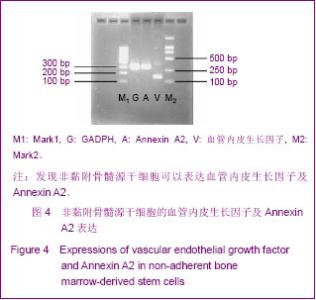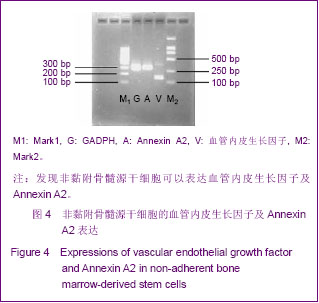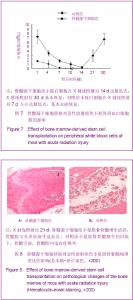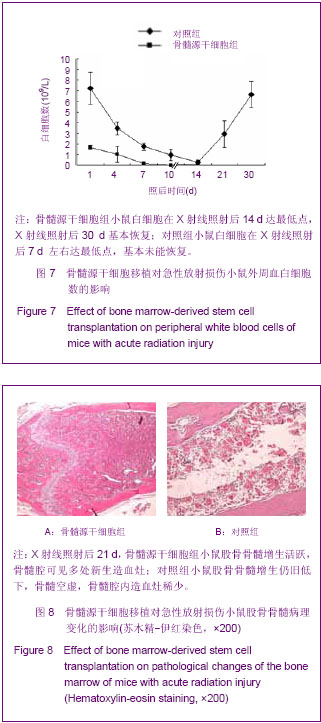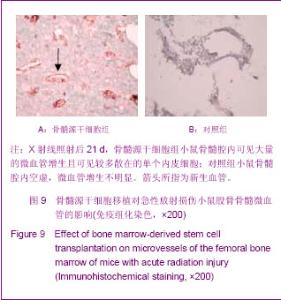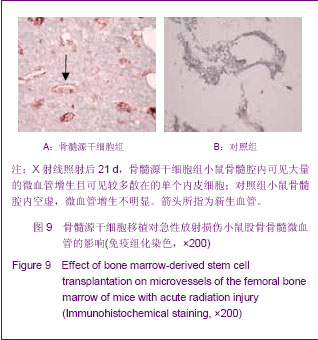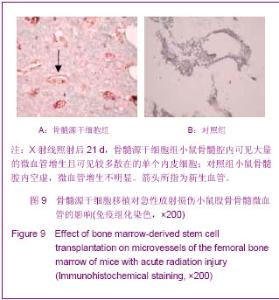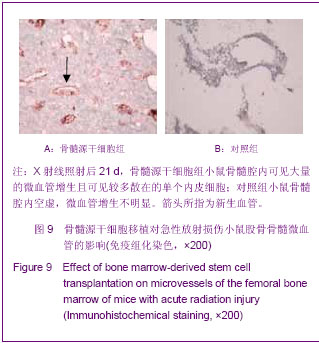Chinese Journal of Tissue Engineering Research
Previous Articles Next Articles
Therapeutic potential of non-adherent bone marrow-derived stem cells for acute radiation injury
Wang Pan-jun1, Fu Jin-xiang1, Sun Yu1, Feng Yi-zhong2, Zhang Hong3, Zhang Xue-guang4
- 1Department of Hematology, Second Affiliated Hospital of Soochow University, Suzhou 215004, Jiangsu Province, China; 2Department of Pathology, Second Affiliated Hospital of Soochow University, Suzhou 215004, Jiangsu Province, China; 3Clinical Laboratory, Second Affiliated Hospital of Soochow University, Suzhou 215004, Jiangsu Province, China; 4Institute of Biotechnology, College of Life Sciences, Suzhou University, Suzhou 215004, Jiangsu Province, China
-
Received:2013-03-25Revised:2013-05-12Online:2013-07-02Published:2013-07-02 -
About author:Wang Pan-jun★, Master, Department of Hematology, Second Affiliated Hospital of Soochow University, Suzhou 215004, Jiangsu Province, China wangpanjun198524@163.com
CLC Number:
Cite this article
Wang Pan-jun, Fu Jin-xiang, Sun Yu, Feng Yi-zhong, Zhang Hong, Zhang Xue-guang . Therapeutic potential of non-adherent bone marrow-derived stem cells for acute radiation injury[J]. Chinese Journal of Tissue Engineering Research, doi: 10.3969/j.issn.2095-4344.2013.27.003.
share this article
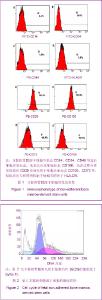
2.1 胎儿骨髓中存在非黏附骨髓源干细胞 采用反复转移法培养人胎儿骨髓细胞发现,反复转移的非黏附骨髓源干细胞可以不断形成具有贴壁能力的间充质干细胞样细胞,分化为成纤维细胞样细胞并形成集落,即CFU-F。非黏附骨髓源干细胞从悬浮状态贴壁后,形态与间充质干细胞相似,呈长梭型或多角形,单个克隆从第3天开始迅速扩增变大,到14 d克隆达最大。 2.2 非黏附骨髓源干细胞的生物学特性 表面抗原分析见图1,显示非黏附骨髓源干细胞不表达CD14 (1.2%)、CD34(0.1%)、CD45(1.6%)等造血细胞表面标志及HLA-DR(1.0%),低表达CD106(38.3%),高表达CD29(98.4%)及间充质干细胞表面标志CD105 (98.8%)、CD73(68.9%)等。 细胞周期分析见图2,显示第7代非黏附骨髓源干细胞仍有69.5%的细胞处于G0/G1期,表明此类细胞反复传代后仍具有较强的增殖潜能。 第7代细胞经成骨培养基诱导后,细胞变成多角形、不规则形,10 d后克隆的中心呈均匀的黑灰色细颗粒状,3周后Von Kossa染色呈黑色,见图3A;用成脂培养基诱导3 d起,光镜下可见脂滴沉着的细胞,1周后脂滴和脂肪细胞数量明显增多,3周后油红O染色见脂滴呈橘红色,见图3B。"
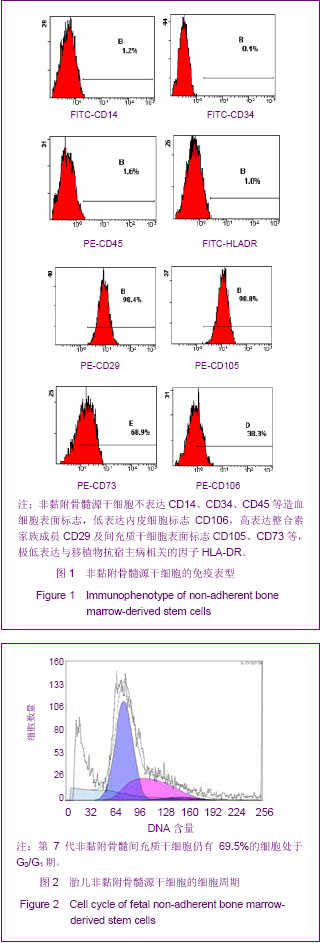
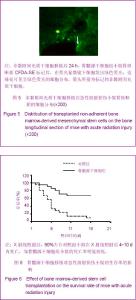
2.3 移植后非黏附间充质干细胞的分布情况 非黏附间充质干细胞移植后24 h,CFDA-SE标记后荧光显微镜观察骨髓源干细胞组小鼠各组织内荧光细胞的分布情况发现,人胎儿骨髓源非黏附骨髓源干细胞植入以骨髓衰竭为主要表现的急性放射病小鼠的体内后主要分布在骨及脾脏,见图5,其余脏器偶见分布,这说明移植的非黏附骨髓源干细胞可以向损伤部位归巢。 2.4 非黏附间充质干细胞移植促进小鼠造血功能恢复 对照组小鼠90%左右在X射线照射后4-10 d内因脏器功能衰竭或感染等原因死亡,而骨髓源干细胞组小鼠的死亡率明显较低,观察至15 d,对照组小鼠存活率9.5%,骨髓源干细胞组小鼠存活率66.7%;之后2组均未再有小鼠死亡,其生存曲线见图6。"
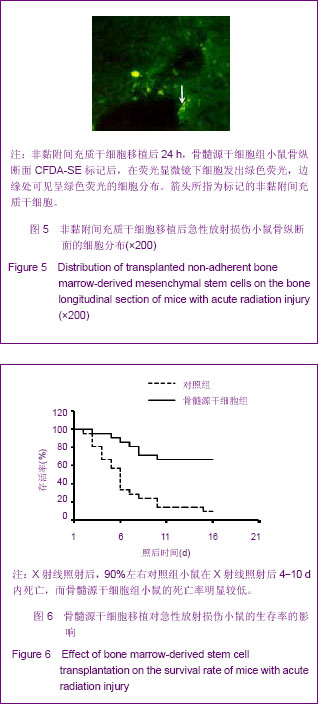
| [1] Doughty HA. Medical management of the haemopoietic syndrome in acute radiation sickness. J R Army Med Corps. 2004;150(3 Suppl 1):11-16.[2] Hatchett RJ. Slow progress in preparing for radiological and nuclear emergencies. Disaster Med Public Health Prep. 2011; 5(3):180-182.[3] Dörr H, Meineke V. Medical management of radiation accidents: capabilities and deployment principles of the Bundeswehr Institute of Radiobiology. Radiat Prot Dosimetry. 2012;151(4):629-632.[4] 艾辉胜,余长林,乔建辉,等.山东济宁 60 Co辐射事故受照人员的临床救治[J].中华放射医学与防护杂志,2007,27(1):1-6.[5] Belyi DA, Khomenko VI, Bebeshko VG. Emergency preparedness of Research Center for Radiation Medicine and its hospital to admit and treat the patients with signs of acute radiation sickness. Radiat Prot Dosimetry. 2009;134(3-4): 159-163.[6] Minguell JJ, Erices A, Conget P. Mesenchymal stem cells. Exp Biol Med. 2001;226(6):507-520.[7] Jones E, McGonagle D. Human bone marrow mesenchymal stem cells in vivo. Rheumatology. 2008;47(2):126-131.[8] Muguruma Y, Yahata T, Miyatake H, et al. Reconstitution of the functional human hematopoietic microenvironment derived from human mesenchymal stem cells in the murine bone marrow compartment. Blood. 2006;107(5):1878-1887.[9] Li Y, Chen S, Yuan T, et al. Mesenchymal stem/progenitor cells promote the reconstitution of exogenous hematopoietic stem cells in Fancg-/-mice in vivo. Blood. 2009;113(10): 2342-2351.[10] Guo LL, Li M, Xing S, et al. New advance of research on therapy of severe acute radiation sickness with mesenchymal stem cells. Zhongguo Shiyan Xueye Xue Zazhi. 2011; 19(3):828-30.[11] Sun CK, Chang CL, Lin YC, et al. Systemic administration of autologous adipose-derived mesenchymal stem cells alleviates hepatic ischemia–reperfusion injury in rats. Crit Care Med. 2012(40):1279-1290.[12] Lucchinetti E, Awad AE, Rahman M, et al. Antiproliferative effects of local anesthetics on mesenchymal stem cells. Anesthesiology. 2012;116(4):841-856.[13] Clarke E, McCann SR. Stromal colonies can be grown from the non-adherent cells in human long-term bone marrow cultures. Eur J Haematol. 1991;46(5):296-300.[14] Wan C, Marsh DR, Li G, et al. Osteogenic potential of human marrow derived mesenchymal stem cells in the pull off non-adherent cell population. J Bone Joint Surg Br Prceedings. 2006;88-b(7):371-372.[15] Fricke S, Ackermann M, Stolzing A, et al. Allogeneic non-adherent bone marrow cells facilitate hematopoietic recovery but do not lead to allogeneic engraftment. PLoS One. 2009;4(7):e6157.[16] Zhang ZL, Tong J, Lu RN, et al. Therapeutic potential of non-adherent BM-derived mesenchymal stem cells in tissue regeneration. Bone Marrow Transplant. 2009;43(1):69-81.[17] Battula VL, Treml S, Bareiss PM, et al. Isolation of functionally distinct mesenchymal stem cell subsets using antibodies against CD56, CD271, and mesenchymal stem cell antigen-1. Haematologica. 2009;94:173-184. [18] Wehner R, Wehrum D, Bornhäuser M, et al. Mesenchymal stem cells efficiently inhibit the proinflammatory properties of 6-sulfo LacNAc dendritic cells. Haematologica. 2009;94(8): 1151-1156.[19] Wang PJ, Zhang XH, Xue LX, et al. Local low dose radiation directly guides mesenchymal stem cells homing to injured cord in mice model. Neur Reg Res. 2010;5(5):331-336.[20] in ‘t Anker PS, Scherjon SA, Keur CK, et al. Isolation of mesenchymal stem cells of fetal or maternal origin from human placenta. Stem Cells. 2004;22(7):1338-1345.[21] Tsai MS, Hwang SM, Chen KD, et al. Functional network analysis of the transcriptomes of mesenchymal stem cells derived from amniotic fluid, amniotic membrane, cord blood, and bone marrow. Stem Cells. 2007;25(10):2511-2523.[22] 傅晋翔,张晓慧,张建华,等.不同来源间充质干细胞生物学特性的比较[J].中国组织工程研究与临床康复,2007,11(24):4661- 4665.[23] Kasper G, Dankert N, Tuischer J, et al. Mesenchymal stem cells regulate angiogenesis according to their mechanical environment. Stem Cells. 2007;25:903-910.[24] Weider N, Semple JP, Welch WR, et al. Tumor angiogenesis and metastasis correlation in invasive breast carcinoma. N Engle J Med. 1991;324(1):1-8.[25] Li Z, Wenyi Z, Liang’an Z. General situation of radiation accidents in china. Radiat Prot Dosimety. 2007;124(2): 177-180.[26] Weisdorf D, Chao N, Waselenko JK, et al. Acute radiation injury: contingency planning for triage, supportive care, and transplantation. Biol Blood Marrow Transplant. 2006; 12(6): 672-682.[27] 苗莉,缪竞诚.细胞因子在急性辐射损伤治疗中的作用[J].国际放射医学核医学杂志,2006,30(3):173-176.[28] Saito T. Acute Radiation Injury. Nihon Rinsho. 2012;70(3): 415-420.[29] 叶根耀.国内外辐射事故的临床诊治新进展[J].中华放射医学与防护杂志,2004,24(1):81-84.[30] Dainiak N, Ricks RC. The evolving role of haematopoietic cell transplantation in radiation injury: potentials and limitations. BJR Suppl. 2005;27:169-174.[31] Dainiak N, Waselenko JK, Armitage JO, et al. The hematologist and radiation casualties. Hematology Am Soc Hematol Educ Program. 2003;473-496.[32] Wehner R, Wehrum D, Bornhäuser M, et al. Mesenchymal stem cells efficiently inhibit the proinflammatory properties of 6-sulfo LacNAc dendritic cells. Haematologica. 2009;94(8): 1151-1156.[33] Nauta AJ, Fibbe WE. Immunomodulatory properties of mesenchymal stromal cells. Blood. 2007;110(10):3499-3506.[34] Sato Y, Araki H, Kato J, et al. Human mesenchymal stem cells xenografted directly to rat liver are differentiated into human hepatocytes without fusion. Blood. 2005;106(2):756-763.[35] Mackenzie TC, Flake AW. Human mesenchymal stem cells persist, demonstrate site-specific multipotential differentiation, and are present in sites of wound healing and tissue regeneration after transplantation into fetal sheep. Blood Cells Mol Dis. 2001;27(3):601-604.[36] Chapel A, Bertho JM, Bensidhoum M, et al. Mesenchymal stem cells home to injured tissues when co-infused with hematopoietic cells to treat a radiation-induced multi-organ failure syndrome. J Gene Med. 2003;5:1028-1038.[37] in't Anker PS, Noort WA, Kruisselbrink AB, et al. Nonexpanded primary lung and bone marrow-derived mesenchymal cells promote the engraftment of umbilical cord blood-derived CD34(+) cells in NOD/SCID mice. Exp Hematol. 2003;31(10):881-889.[38] Le Blanc K, Rasmusson I, Sundberg B, et al. Treatment of severe acute graft-versus-host disease with third party haploidentical mesenchymal stem cells. Lancet. 2004;363 (9419): 1439-1441.[39] Greenberger JS, Epperly M. Bone marrow–derived stem cells and radiation response. Semin Radiat Oncol. 2009;19(2): 133-139.[40] Dominici M,Pritchard C,Garlits JE,et al. Hematopoietic cells and osteoblasts are derived from a common marrow progenitor after bone marrow transplantation. Proc Natl Acad Sci U S A. 2004;101(32):11761-11766.[41] Gaugler MH. A unifying system: does the vascular endothelium have a role to play in multi-organ failure following radiation exposure? BJR. 2005;27:100-105.[42] Abarbanell AM, Wang Y, Herrmann JL, et al. Toll-like receptor 2 mediates mesenchymal stem cell-associated myocardial recovery and VEGF production following acute ischemia-reperfusion injury. Am J Physiol Heart Circ Physiol. 2010;298(5):H1529-H1536.[43] Udagawa T, Birsner AE, Wood M, et al. Chronic suppression of angiogenesis following radiation exposure is independent of hematopoietic reconstitution. Cancer Res. 2007;67(5): 2040-2045. |
| [1] | Pu Rui, Chen Ziyang, Yuan Lingyan. Characteristics and effects of exosomes from different cell sources in cardioprotection [J]. Chinese Journal of Tissue Engineering Research, 2021, 25(在线): 1-. |
| [2] | Zhang Xiumei, Zhai Yunkai, Zhao Jie, Zhao Meng. Research hotspots of organoid models in recent 10 years: a search in domestic and foreign databases [J]. Chinese Journal of Tissue Engineering Research, 2021, 25(8): 1249-1255. |
| [3] | Wang Zhengdong, Huang Na, Chen Jingxian, Zheng Zuobing, Hu Xinyu, Li Mei, Su Xiao, Su Xuesen, Yan Nan. Inhibitory effects of sodium butyrate on microglial activation and expression of inflammatory factors induced by fluorosis [J]. Chinese Journal of Tissue Engineering Research, 2021, 25(7): 1075-1080. |
| [4] | Wang Xianyao, Guan Yalin, Liu Zhongshan. Strategies for improving the therapeutic efficacy of mesenchymal stem cells in the treatment of nonhealing wounds [J]. Chinese Journal of Tissue Engineering Research, 2021, 25(7): 1081-1087. |
| [5] | Liao Chengcheng, An Jiaxing, Tan Zhangxue, Wang Qian, Liu Jianguo. Therapeutic target and application prospects of oral squamous cell carcinoma stem cells [J]. Chinese Journal of Tissue Engineering Research, 2021, 25(7): 1096-1103. |
| [6] | Xie Wenjia, Xia Tianjiao, Zhou Qingyun, Liu Yujia, Gu Xiaoping. Role of microglia-mediated neuronal injury in neurodegenerative diseases [J]. Chinese Journal of Tissue Engineering Research, 2021, 25(7): 1109-1115. |
| [7] | Li Shanshan, Guo Xiaoxiao, You Ran, Yang Xiufen, Zhao Lu, Chen Xi, Wang Yanling. Photoreceptor cell replacement therapy for retinal degeneration diseases [J]. Chinese Journal of Tissue Engineering Research, 2021, 25(7): 1116-1121. |
| [8] | Jiao Hui, Zhang Yining, Song Yuqing, Lin Yu, Wang Xiuli. Advances in research and application of breast cancer organoids [J]. Chinese Journal of Tissue Engineering Research, 2021, 25(7): 1122-1128. |
| [9] | Wang Shiqi, Zhang Jinsheng. Effects of Chinese medicine on proliferation, differentiation and aging of bone marrow mesenchymal stem cells regulating ischemia-hypoxia microenvironment [J]. Chinese Journal of Tissue Engineering Research, 2021, 25(7): 1129-1134. |
| [10] | Zeng Yanhua, Hao Yanlei. In vitro culture and purification of Schwann cells: a systematic review [J]. Chinese Journal of Tissue Engineering Research, 2021, 25(7): 1135-1141. |
| [11] | Kong Desheng, He Jingjing, Feng Baofeng, Guo Ruiyun, Asiamah Ernest Amponsah, Lü Fei, Zhang Shuhan, Zhang Xiaolin, Ma Jun, Cui Huixian. Efficacy of mesenchymal stem cells in the spinal cord injury of large animal models: a meta-analysis [J]. Chinese Journal of Tissue Engineering Research, 2021, 25(7): 1142-1148. |
| [12] | Hou Jingying, Yu Menglei, Guo Tianzhu, Long Huibao, Wu Hao. Hypoxia preconditioning promotes bone marrow mesenchymal stem cells survival and vascularization through the activation of HIF-1α/MALAT1/VEGFA pathway [J]. Chinese Journal of Tissue Engineering Research, 2021, 25(7): 985-990. |
| [13] | Shi Yangyang, Qin Yingfei, Wu Fuling, He Xiao, Zhang Xuejing. Pretreatment of placental mesenchymal stem cells to prevent bronchiolitis in mice [J]. Chinese Journal of Tissue Engineering Research, 2021, 25(7): 991-995. |
| [14] | Liang Xueqi, Guo Lijiao, Chen Hejie, Wu Jie, Sun Yaqi, Xing Zhikun, Zou Hailiang, Chen Xueling, Wu Xiangwei. Alveolar echinococcosis protoscolices inhibits the differentiation of bone marrow mesenchymal stem cells into fibroblasts [J]. Chinese Journal of Tissue Engineering Research, 2021, 25(7): 996-1001. |
| [15] | Fan Quanbao, Luo Huina, Wang Bingyun, Chen Shengfeng, Cui Lianxu, Jiang Wenkang, Zhao Mingming, Wang Jingjing, Luo Dongzhang, Chen Zhisheng, Bai Yinshan, Liu Canying, Zhang Hui. Biological characteristics of canine adipose-derived mesenchymal stem cells cultured in hypoxia [J]. Chinese Journal of Tissue Engineering Research, 2021, 25(7): 1002-1007. |
| Viewed | ||||||
|
Full text |
|
|||||
|
Abstract |
|
|||||
